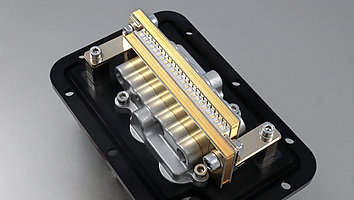FBH presents high-performance semiconductor light sources at Photonics West 2024
Diode lasers and UV LEDs for versatile applications: from materials processing, LiDAR, sensor technology, and health care to quantum technologies
At Photonics West 2024 in San Francisco (USA), the Ferdinand-Braun-Institut (FBH) will be presenting novel and advanced diode lasers and UV light-emitting diodes (LEDs). FBH will be participating in both the trade fair (January 30 to February 1, 2024) and the accompanying conferences (January 27 to February 1, 2024) with more than 20 scientific talks. At stand 4205-43 in the German Pavilion, the Berlin-based institute will be showcasing its full range of services – from design and chip development to modules and prototypes. In addition to established diode laser-based light sources, it will present advances in high-power diode lasers and showcase an LED-based irradiation system. This unit can be equipped in particular with inhouse-developed far-UVC LEDs. Wavelengths in the region around 233 nm, for example, are ideally suited for surface disinfection. These LEDs can even be used directly on the skin to render bacteria or viruses harmless. Far-UVC LEDs emitting at 226 nm can be used to measure the concentration of nitrogen oxide.
New developments and exhibits include:
High-power diode lasers with wide aperture and high efficiency for materials processing
To reduce cost per device and scale performance, single emitters are increasingly being produced with larger lateral stripe widths exceeding 100 µm. Scientists at the Ferdinand-Braun-Institut have recently realized gallium arsenide-based 915 nm broad area lasers with an aperture of 1,200 µm, which offer excellent output power and high efficiency. In quasi-continuous mode (QCW), they deliver 93 watts of output power per emitter with 70 % efficiency. In continuous wave (CW) operation, these lasers achieve top values with a peak power of 62 watts and 62 % efficiency. The stripe width of the device can be varied within a range of 100 µm to 1,500 µm. In this way, the maximum efficiency at lower or higher output powers can be specifically adjusted to suit the respective application. In addition, the far-field divergence has been improved by the newly developed BRIS technology (Buried Regrown Implant Structure) at the FBH, which allows the laser light to be efficiently coupled into glass fibers. The diode lasers manufactured in this way are ideal for use in efficient, direct materials processing.
From diode lasers to compact fiber-coupled modules
Laser modules with and without fiber output developed by FBH convert light from the infrared spectral range into visible light via frequency doubling. These modules are key components for a wide range of life science applications, including medicine, bio analytics, and fluorescence measurements. Diode lasers, non-linear crystals and further components are integrated into a butterfly housing with a maximum footprint of 76 mm x 44 mm and can thus further miniaturize existing laser systems. They can provide very efficiently several hundred milliwatts of CW output power via polarization-maintaining single-mode fibers. At a wavelength of 532 nm, for example, the modules achieve more than 200 milliwatts output power. This emission can be realized at almost any wavelength in the range between 460 nm and 592 nm.
The Ferdinand-Braun-Institut develops and realizes diode lasers for these and other applications in the wavelength range between 620 nm and 1180 nm. For example, the epitaxial structure of DBR tapered lasers at 1180 nm has been optimized – with a special focus on the high strain in the quantum wells. As a result, the 6 mm long diode lasers now deliver an optical output power of more than 9 watts. They are characterized by a narrow spectral width and excellent beam quality – with a demonstrated lifetime of more than 3,000 hours at an optical power of 7 watts without failures.
The FBH has also developed novel diode lasers suited for laser cooling of beryllium ions and calcium fluoride, for example. They emit laser light with a narrow spectral linewidth at center wavelengths around 626 nm and 628 nm with almost diffraction-limited beam quality. Almost any wavelength in the range between 618 nm and 633 nm can be realized, including laser wavelengths used in quantum technology applications. The diode lasers are available mounted in TO housings and on C-mounts – and are also offered as modules with fiber output.
226 nm far-UVC LEDs for gas sensing
UV LEDs with wavelengths below 240 nm are ideal light sources both for surface disinfection and for sensor applications. In this context, nitrogen oxide with its pronounced absorption line at 226 nm is of particular interest. As a toxic gas, it must be monitored in the exhaust systems of power plants and combustion engines. Until now, bulky and costly light sources based on gas discharge lamps and optical filters have been used for this purpose. Light-emitting diodes, however, offer a much more compact alternative. FBH has developed corresponding LEDs based on the findings of previously optimized 233 nm LEDs. Meanwhile, 226 nm UVC LEDs are available, which achieve an emission power of 1.2 milliwatts and an operating voltage of 9.6 volts at 200 milliamperes.


